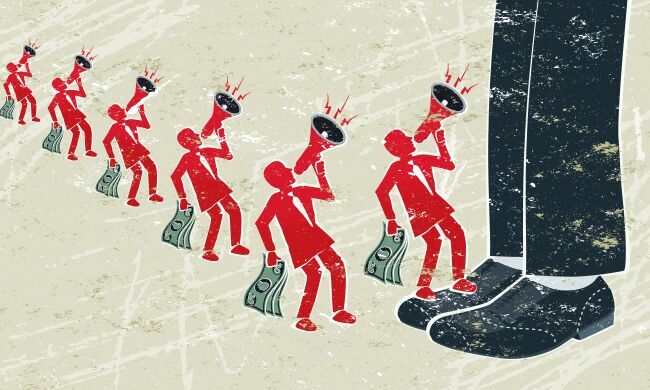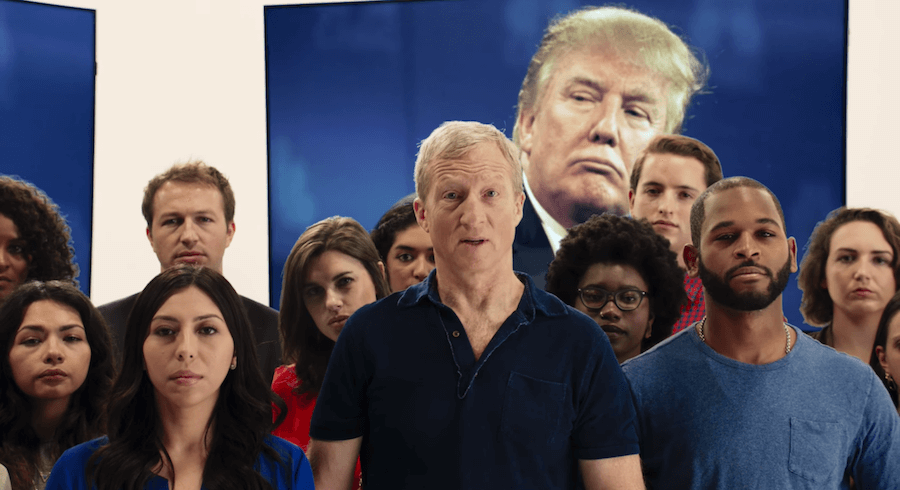The progressive advocacy group Demos released a study examining the demographics of the “elite donor” class, arguing that its makeup unfairly shapes policy formation in America.
Their study finds that the biggest political contributors are proportionally more white and male than small and non-donors, that their policy preferences are more conservative than Americans as a whole, and that their influence therefore tilts U.S. politics more to the right than voters would like. From this, the study concludes that dramatically greater political speech regulation is necessary for American democracy to truly represent the will of the people.
We can divide the major flaws of this study into a few categories: (1) the methodology determining donor demographics and policy preferences is lacking; (2) the presumption that large campaign contributions directly influence policy outcomes is unfounded; and (3) the implications for free speech rights are dangerous.
I. Methodology for Donor Demographics and Policy Preferences
Figures 1 through 9 show how “elite donors” (those giving over $5,000) are less diverse than the country overall by race (“white” versus “people of color”), gender, and wealth. Small donors (less than $200) supposedly better represent the U.S. population. Donor demographics come from two sources: FEC data analyzed by a proprietary voter database called Catalist and Cooperative Congressional Election Studies (CCES) surveys. There are a few significant problems with these methods.
First, the definition of “elite donors” is inconsistent. The FEC data Demos uses only counts those who give to candidates and joint fundraising committees, excluding donors to PACs and super PACs (Appendix A). CCES data asks survey respondents to self-report contributions to candidates, campaigns, and “political organizations” (Footnote 25). Given the low legal limits at the federal level on campaign contributions (the current $2,700 limit is effectively 50% lower than the limit first imposed in 1974, when adjusted for inflation), it does not make sense to compare contributions to candidates with giving to organizations like super PACs and advocacy groups that are not limited by law. Nor does it make sense to suggest that individual donors can sway lawmakers’ views by giving a few thousand dollars to candidates who raise millions. Demos does not even specify whether it counts aggregate donations or those going to a single lawmaker – $5,000 in donations is less impactful if it is split between 10 candidates.
The second problem is the sources themselves. Contributions under $200 are only reported to the FEC voluntarily, and thus rarely. This leads to massive selection bias in analyzing small donors, seriously compromising FEC figures. CCES asks respondents to voluntarily record all their donations, but does not define “political organizations.” These inconsistencies mean the true demographics of donors as a whole – even those who give only a few dollars – are unknown. There is no way to say confidently whether small donors are more representative of the U.S. population than “elite donors.” The paper itself suggests that about 15% of small donors are millionaires (in the 2014 cycle), compared to 3% of Americans who are classified as such.
The methodology for determining political preferences – using CCES surveys about certain issues – is also questionable. It is worth noting that the definition of “elite donor” changes here; it counts those who gave more than $5,000 in a single election year as “elite,” while the demographics analysis counts those who gave more than $5,000 in a two-year election cycle. The study effectively cuts the “elite” threshold in half.
The survey asked respondents in 2010 whether they support “Obama Agenda” items (e.g. the American Recovery and Reinvestment Act (“The Stimulus Package”), Affordable Care Act (ACA), and Dodd-Frank), and so-called “Austerity” Agenda items (e.g. Paul Ryan Budget and Simpson-Bowles Budget) in 2012-14. The results suggest Americans were more supportive of the Obama Agenda and less supportive of the “Austerity” Agenda than “elite donors.” This implies moneyed insiders shifted American politics to the right, despite an unwilling populace.
But the wording of many survey questions likely affected support for liberal and conservative policies. The Obama Agenda policy questions ask if respondents support laws that “stimulate economic growth” (Stimulus), “[allow] people to keep current provider” (ACA), “[protect] consumers,” and “[regulate] high risk investments known as derivatives” (Dodd-Frank). Compare this with “Austerity Agenda” questions, which focus on cuts to popular entitlement programs (Medicare and Medicaid), reference debt reduction projections without citing sources, and omit future debt projections under the status quo. Given the rosy descriptions of Obama’s proposals and intentions (despite real–world outcomes), inflated support among respondents is unsurprising – particularly since non-donors may be less informed about those policies than donors, who are, by definition, more engaged in the political process.
II. Whether Large Campaign Contributions Directly Impact Policy
Besides questions about supposed demographic and ideology gaps, there is the matter of whether large contributors dictate policy formation. The standard narrative is that politicians stay on good terms with their biggest donors by acceding to their policy preferences in exchange for continued financial backing.
The authors cite several papers to support this theory (below are six non-paywalled studies):
- Flavin and Franko (2016) and Gilens and Page (2014) argue lawmakers prioritize issues of greater importance to the wealthy than to others (they do not focus on large contributors specifically). The former study lacks statistical significance on many issues the authors measure and disregards whether lawmakers also prioritize issues based on their personal wealth. Flavin and Franko also acknowledge there is scant evidence that donations directly dictate votes. An analysis cited in the Demos footnotes actually refutes the latter paper by pointing out “the rich and middle [class] agree more than 90 percent of the time; when they disagree, the rich win only a little more often than the middle.”
- Barber (2016) measures congruence between the views of legislators and different constituent groups, finding that U.S. senators match most closely with the average donor (not “elite” donors), and match least with the average voter. However, Barber shows that senators and their general supporters match closely too. It is unsurprising that politicians are more concerned with appealing to donor and non-donor supporters than those who do not vote for them.
- Witko and Newmark (2005) find that “business mobilization” through lobbying and campaign contributions leads to better state “business policy climate[s].” However, measuring campaign contributions from a firm really means measuring employee contributions, either directly or through a regulated company PAC. This is not limited to “elite donors.”
- Enns, Kelly, Morgan, and Witko (2016) say lawmakers “signal” their support for issues relevant to wealthy interests in order to receive contributions in the future. But this suggests that legislators’ views determine donations rather than vice versa. Furthermore, the authors claim issues like stock market performance and productivity exclusively appeal to the wealthy. However, these indicators impact all Americans through retirement accounts or wage growth.
- Jayachandran (2004) saw correlations between firms that donate to Republicans and their market performance when a GOP Senator switched parties. But this study ignores legislative votes entirely, instead using market valuation as the sole indicator of political support for a firm, and repeatedly (and falsely) stating that firms directly donate to candidates.
The aforementioned studies fit similar patterns: either focusing on wealthy people or average donors rather than “elite donors,” or failing to prove contributions affect lawmakers’ votes or viewpoints. Indeed, there are numerous studies that reject the notion that campaign contributions or personal wealth determine votes. The premise that “elite donor” viewpoints or demographics have a major impact on American politics is, believe it or not, empirically unfounded.
A common sense approach to analyzing donations suggests that, rather than politicians changing their views to reflect the will of their donors, donors contribute to those with whom they already agree. Why try to change a senator’s mind when there are others with whom you already share a common policy goal, particularly since donors are not monolithic and have distinct views and interests? If donations really swayed politicians as significantly as Demos suggests, there would be no reason for rich Democrats or Republicans to donate primarily to members of their own party.
III. Demos’s Conclusion and its Implications
This study’s unconvincing case that “elite donors” are uniquely out of touch with the country and responsible for Demos’s favored progressive policies not becoming law should be enough to undermine Demos’s case that public policy is being hijacked by “elite donors.” However, their policy recommendations can be rejected on their merits as well.
The worst recommendations are for increased disclosure requirements for “nonprofits, Super PACs and electioneering communications,” public financing of candidate campaigns, and “transform[ing] the Supreme Court’s flawed approach to money in politics.” CCP has written extensively on the risks of each of these policies.
Further disclosure is unnecessary because the vast majority of money spent in elections is already disclosed – meaning the names, addresses, and employers of political donors over $200 are publicized. Increased disclosure also means potentially exposing anonymous speakers and critics of the government to harassment. Our disclosure Policy Primer discusses these issues, and others, in greater detail.
“Public” financing of elections – besides forcing taxpayers to subsidize politicians they disagree with – also fails to accomplish its supporters’ stated goals. It does not increase the diversity of lawmakers by occupation or gender, nor does it reduce the influence of lobbyists or special interests, alter legislative voting behavior, or increase voter participation. CCP has explained each of these issues – and then some – in our Policy Primer on taxpayer financing of campaigns.
Demos’s desire to overturn the over 40-year old Supreme Court precedent from Buckley v. Valeo is most troubling of all. At the core of Buckley is the simple idea that using money to support a candidate or spread your views is protected under the First Amendment. As the Court ruled, preventing corruption or the appearance of corruption are the only legitimate justifications for government limiting free speech rights for individuals and groups of individuals. However, Demos wishes to include the vague standard of “equal citizenship” as another reason to regulate speech. Put another way, this standard would allow government to step in if Demos’s progressive views are being underrepresented in the political system – blaming poor electoral performance on a lack of adequate taxpayer subsidies or insufficient restrictions on the speech of those with competing views.
This last point encapsulates the entire logic of this paper in simple terms. By obsessively cataloging the race and gender of certain donors, and defining these characteristics as the most important determinants of political opinion, Demos signals that it wants government regulation based on individual identity rather than fundamental liberties. There is probably no worse justification for restricting speech than, “we don’t like how this group of donors looks or thinks.”
Demos’s study fails to prove the underlying need for its “reforms,” and the proposals themselves represent an ugly identity politics that prioritizes progressive-friendly outcomes over the First Amendment to the Constitution. It is yet another reason why Americans must be wary of attempts to control their right to participate in politics.














